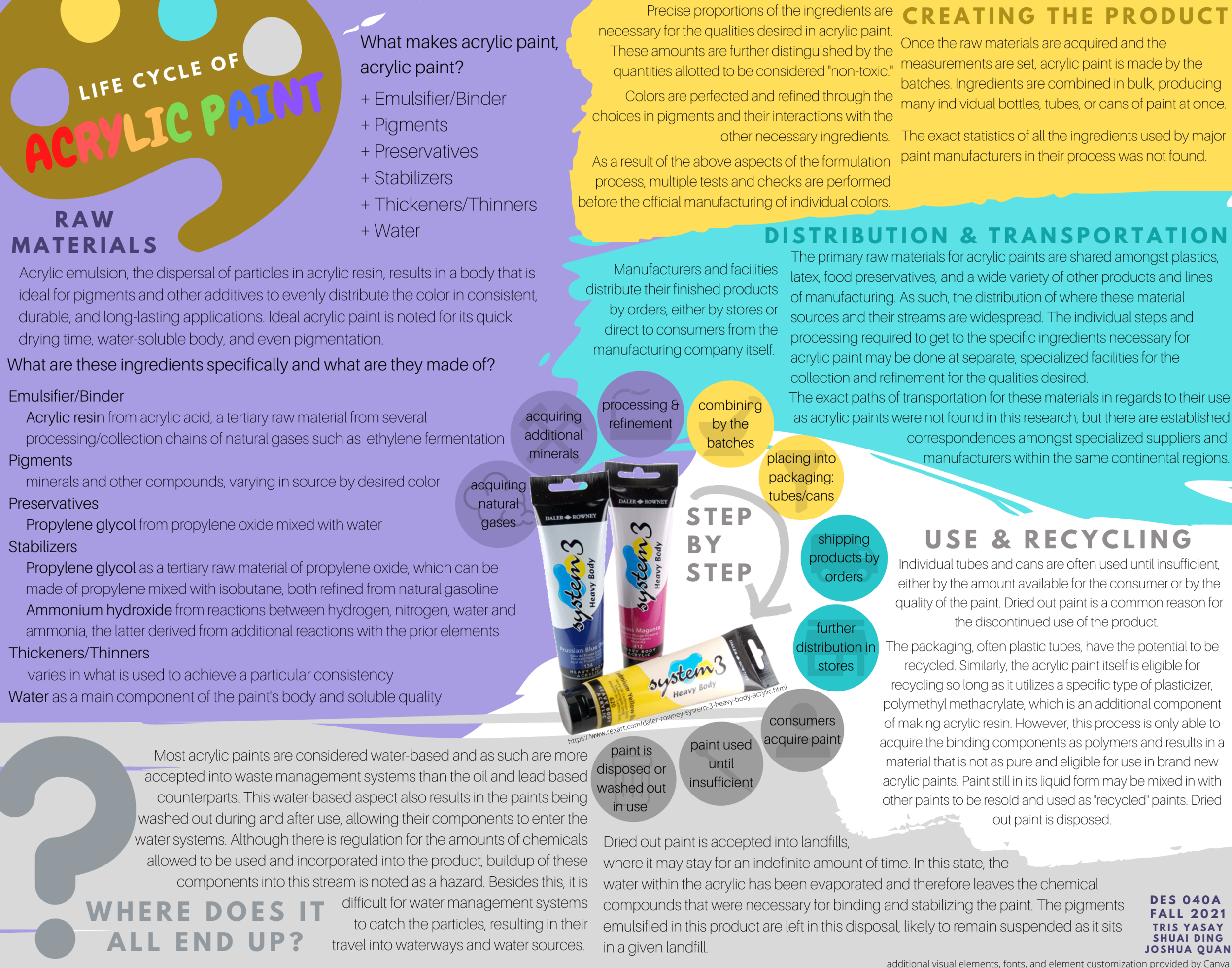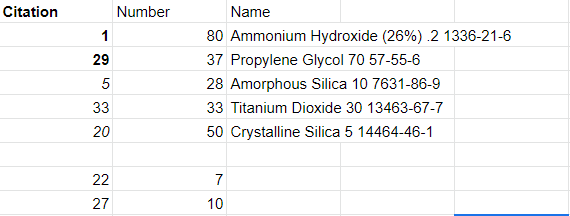Design Life-Cycle
assess.design.(don't)consume
Tris Yasay
Christina Cogdell
DES 040a
02 December 2021
The Raw Materials of Acrylic Paint
Acrylic paint is regarded as a staple art medium for its versatility and range in color application. Its invention was inspired by the properties of watercolor paints and oil paints, specifically the solubility and blending of watercolor and the even and vibrant saturation of oil paint. Similarly, the raw materials involved to make acrylic paints emulate these mixed properties and are refined to interact in specific ways as the formulations of acrylic paint. As a result, the raw materials that go into making acrylic paints go through a variety of different processes to meet the behavioral expectations of this medium and their life cycle, for the most part, ends up as a one way stream from its acquisition to the product creation, use, and disposal.
This journey from acquisition to disposal has yet to be discussed in regards to the materials coming together as ingredients for acrylic paint. Instead, the individual components from the absolute start as a natural resource and the following refined iterations are looked into on their own. This research has allowed for acrylic paint to be noted for its potential dangers to environmental systems as seen in articles, such as PaintTopic and earth911, which discuss how the product should be disposed of to minimize its impacts. Yet, in my findings, the reasoning and connections between the ingredients to the final product have yet to be explored and are only generally acknowledged. As such, I will focus this discussion on explaining how and why particular materials are involved in acrylic paints and their involvements with other systems.
As stated by Liquitex, an acrylic paint manufacturer, acrylic paints are composed of three main ingredients: pigments, a binder, and water. Pigments are the particles most responsible for giving the paint its color and are the most varied in their source. Binders and water come together to form an acrylic emulsion, the body by which the pigment particles are suspended and dispersed within. The binder is what gives acrylic paint its name, being composed of acrylic polymers or resin. There are additional ingredients that are necessary for the maintenance of the paint: stabilizers and preservatives (Takahashi 2020). Propylene glycol acts in both of these roles alongside ammonium hydroxide which is an additional stabilizer. These two compounds were not directly cited by Liquitex as ingredients for their paints, nor were they defined as fulfilling these roles by my source of their names, Golden Paints.
Golden Paints is another manufacturer of acrylic paints and they provide a list for all of their paint colors, as well as their commitment to following chemical regulations to what they use. In order to associate the compounds with their roles, I had to make the assumption that the most common ingredients across the different individual paint colors were the main ingredients involved with creating their acrylic paints (Table 1). When looking into these compounds individually, they were either confirmed as a part of acrylic paints or described as having properties which were akin to the types of ingredients necessary for acrylics. From here I was able to define the main materials as acrylic resin, pigments, propylene glycol, ammonium hydroxide, and water. The manufacturers I gathered information from did not reveal their sources for their ingredients, but the processes involved to create these materials are documented in chemical databases and health research.
The main materials of acrylic paint can be traced back through the defined processes involved for its components. The U.S. National Library of Medicine hosts a compound database which provides cited information on the industry behind a chemical compound in its use and its creation. With this resource, I was able to determine that the majority of the ingredients established are specific refinements of natural gases or fossil fuels that have gone through several stages of chemical formulation. For example, acrylic acid, a component to acrylic resin, is sourced from the condensation of ethylene oxide and hydrocyanic acid reacting with sulfuric acid (PubChem). Ethylene oxide is a derivative of ethanol which in turn is derived from ethylene of which is commercially provided by the “steam cracking” of petroleum hydrocarbons. Similarly, ammonium hydroxide and propylene glycol are several derivatives of the ultimate raw material: petroleum. Notably, this is a source shared amongst many other lines of manufacturing.
The materials involved for acrylic paints are, in a way, cousins to hundreds of other products. When looking through the information of the individual components along the way to the ingredients necessary for acrylic paint, I took notice of the vast variety of industries these compounds were a part of. From fashion to crafts, food to technology, these components in at least one part of their journey could have been involved with the development of a product wholly different from what it has become. As such, the tracing of the raw material to the point of it becoming acrylic paint is extremely difficult if not impossible. The intersections across industries and the common demand of a particular starting compound result in interweaving branches of possible paths by which the material could go back and forth between different facilities for different types of processing. Because of this general source being so refined and perfected for a specific use in acrylics, it is difficult for the material to be used in any other manner.
The durable hold on pigments that acrylic paints are found appealing for is the same quality that results in the difficulty for it to be sought out and used again. The recycling of acrylic paints is variable in its capabilities and even acceptability. The acrylic polymers used for binding have the potential to be separated from the paint and used again for creating new batches, but not without the difficulty and expense from performing the action on a limited type of polymer (Reference IAC 2020). Furthermore, once the paint is dried, the pigments and other compounds mixed in are trapped in a way that is difficult to separate and extract from (PaintTopics). With these limitations in mind, I assume that this process cannot match the rate of consumption for acrylic paints.
I could not find a collective amount of total acrylic paint produced in a year for a given country or company. Instead, I looked to the American Geosciences Institute which reports that 7.28 billion barrels of petroleum based products have been consumed in the year 2017. With the acknowledgement of the multitude of industries that could be involved in this number, I make the assumption based on the common occurrence of seeing paints as a resulting product for the chemical compounds involved that the amount of new petroleum used in acrylic paints is a small, yet significant portion of the amount reported. With the total value being in the billions, I will state that the value used for acrylic paints may be in the millions. In light of all these assumptions, I define that there is a single stream of loss of the raw materials in its consumption as acrylic paint.
Acrylic paints are made to be used, intended to be completely consumed in the sense that they have been applied to art or decor that their user has intended them for. Once the project is finished or the paint has become insufficient in amount or quality, it is likely that a consumer would dispose of their tube or can and get one that is new. The only other stream past this point is in recycling, but not in the sense that the materials are acquired once more for another round. Rather, the paint is taken and mixed with other colors of paint (earth911). With the basis of materials the same, the formula could be preserved to suspend a new set of pigments or rather add to the pigments it already had. However, this journey would lead to the same end. Being used up until insufficient and cast aside for one that is new.
This one way stream of materials, energy, and efforts can leave one to think of only the loss in this product’s use of its resources. Yet, it may be considered worth all that input when you see what is made because of it. Acrylic paint is an artist’s medium, a mode to create and express beyond and alongside the senses. It has been manufactured in these ways because it is what works. It has been formulated with the ingredients it has because of the behaviors necessary for it to hold its colors, to blend into itself, and to stick to wherever its user desires. It has worked well for what it was designed to do and has developed with materials that have been actively made available for it in a world already built off of fossil fuels. However, it does not need to remain this way. From doing this research, I not only learned how there are shortcomings to how the raw materials are taken back and managed, but how in light of this there are efforts to do better. In taking apart the individual pieces and in understanding how the stream ends, I am sure it will be possible that the life of acrylic paint can truly become a cycle.
Works Cited
“Acrylic Acid.” National Center for Biotechnology Information. PubChem Compound Database, U.S. National Library of Medicine, pubchem.ncbi.nlm.nih.gov/compound/Acrylic-acid.
Acrylic Art World. “How to Dispose of Acrylic Paint.” Acrylic Art World, 17 May 2021, acrylicartworld.com/how-to-dispose-of-acrylic-paint/.
Ammonium Hydroxide Manufacturing Process - Hill Brothers. hillbrothers.com/pdf/Product-Profiles/Ammonium-Hydroxide-Manufacturing-Process.pdf
“Anhydrous Ammonia.” Anhydrous Ammonia - an Overview | ScienceDirect Topics, www.sciencedirect.com/topics/engineering/anhydrous-ammonia.
“Can Acrylic Be Recycled?” Reference, IAC Publishing, 29 Mar. 2020, www.reference.com/world-view/can-acrylic-recycled-e8f74b54a7e85215.
Chen, Xiaobo, and Samuel S. Mao. “Titanium Dioxide Nanomaterials: Synthesis, Properties, Modifications, and Applications.” ACS Publications, pubs.acs.org/doi/10.1021/cr0500535.
“Crystalline Silica - Cancer-Causing Substances.” National Cancer Institute, www.cancer.gov/about-cancer/causes-prevention/risk/substances/crystalline-silica.
Gavett, Ben. Golden Master SDS - Golden Artist Colors. goldenhub.goldenpaints.com/storage/uploads/golden-master-sds-011816.pdf.
“From Lab to Tube: How Our Acrylic Paint Is Made.” Liquitex, www.liquitex.com/us/our-story/from-lab-to-tube/.
“How Much Oil Is Consumed in the United States?” American Geosciences Institute, 4 Jan. 2019, www.americangeosciences.org/critical-issues/faq/how-much-oil-consumed-united-states.
“How to Dispose of Acrylic Paint Properly.” PaintTopics, 18 Mar. 2021, painttopics.com/how-to-dispose-of-acrylic-paint/.
How to Recycle Paint - earth911. earth911.com/recycling-guide/how-to-recycle-paint/.
Jacob, Sharon E., et al. “Propylene Glycol : Dermatitis.” LWW, journals.lww.com/dermatitis/Fulltext/2018/01000/Propylene_Glycol.2.aspx.
Merget, R., et al. “Health Hazards Due to the Inhalation of Amorphous Silica.” Springer-Verlag, 29 Nov. 2001, pp. 625–634., link.springer.com/content/pdf/10.1007/s002040100266.pdf.
“Methacrylic Acid.” National Center for Biotechnology Information. PubChem Compound Database, U.S. National Library of Medicine, pubchem.ncbi.nlm.nih.gov/compound/Methacrylic-acid#section=Methods-of-Manufacturing.
“Paint Making.” Kroma Artist's Acrylics, kromaacrylics.com/pages/the-paint-making-process.
“Propylene Glycol.” Centers for Disease Control and Prevention, Centers for Disease Control and Prevention, 10 Feb. 2021, wwwn.cdc.gov/TSP/substances/ToxSubstance.aspx?toxid=240.
“Quality Art Materials for Creative People. Convenient and Versatile Products.” Outlines Art, 3 Mar. 2021, outlinesart.com/articles/acrylics-disposing-of-rinse-water/.
“Silicone Oil Recycling.” Silicone Recycling, 15 Feb. 2019, www.siliconerecycling.com/silicone-oil-recycling/.
Skocaj, Matej, et al. “Titanium Dioxide in Our Everyday Life; Is It Safe?” Radiology and Oncology, Versita, Warsaw, Dec. 2011, www.ncbi.nlm.nih.gov/pmc/articles/PMC3423755/.
Takahashi, Lisa. “Acrylic Paint Guide.” Jackson's Art Blog, 2 June 2020, www.jacksonsart.com/blog/2020/06/02/acrylic-paint-guide/.
Turner, Rick. “What Is an Acrylic Polymer Emulsion?” Gellner Industrial LLC, 30 May 2017, www.gellnerindustrial.com/acrylic-polymer-emulsion/.
“What Are Silicone Oils?” Elkem.com, www.elkem.com/silicones/technologies/basic-silicones-products/oils/.
“What Is Acrylic Paint?” Liquitex, www.liquitex.com/us/knowledge/what-is-acrylic-paint/.
What is titanium dioxide? TDMA. (2020, February 18). Retrieved November 12, 2021, from http://tdma.info/what-is-titanium-dioxide/.
Supporting Images
Table 1. A data summary of the most common ingredients involved in Golden Paints product line

